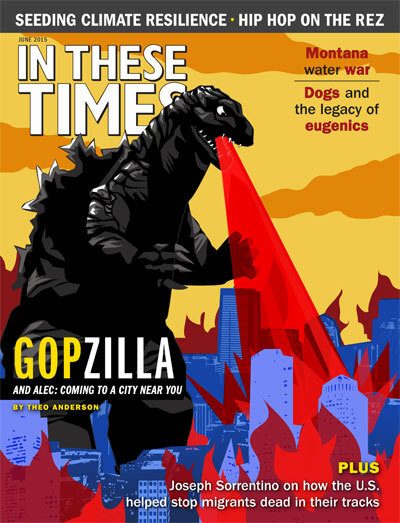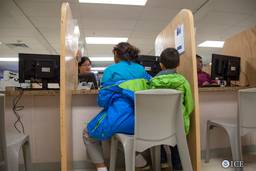How the U.S. ‘Solved’ the Central American Migrant Crisis
By getting Mexico to do its dirty work—and making tens of thousands of migrants more vulnerable to rape, kidnapping, extortion and murder.
Joseph Sorrentino

La Bestia is running empty now.
For years, the freight trains collectively known as “The Beast” carried Central American migrants north through Mexico on their quest to reach the U.S. border, fleeing extreme poverty and violence in their home countries. Hundreds could be seen crammed on top of the cars, riding between them or clinging to ladders on the sides. It’s easy to fall off the bumpy trains. Many who do are killed or lose limbs. “It’s dangerous — dangerous, but free,” says Santos Ricardo Molina Campos, a 37-year-old Salvadoran who rode La Bestia when he migrated to the United States 24 years ago — and again in December, after being deported.
But he’s among the minority. These days, the trains carry only a handful of migrants, or none at all.

Migrants stop and stare as a freight train passes by La Sagrada Familia, a shelter in Apizaco, Tlaxcala, Mexico. The trains once carried hundreds of migrants.
Migrants haven’t stopped coming; they’ve just been forced to find other, even more dangerous routes. That’s because of Programa Frontera Sur, Mexico’s “South Border Program,” implemented in July 2014 and aimed in large part at clearing the trains of migrants. The plan is the latest in a line of Mexican policies funded or tacitly endorsed by the United States that have failed to curb — and sometimes exacerbated — what the Washington Office on Latin America (WOLA) calls “one of the most severe humanitarian crises in the Western Hemisphere”: the routine rape, assault, extortion, abduction and murder of Central American migrants as they cross Mexico.
Stopping the surge
When news broke in June 2014 that an unprecedented 50,000 unaccompanied Central American children had arrived at the U.S. border since October 2013, the White House declared it an “urgent humanitarian situation.” President Barack Obama met with Mexican President Enrique Peña Nieto “to develop concrete proposals to address the root causes of unlawful migration from Central America,” according to a White House statement. Two and a half weeks later, Peña Nieto announced Programa Frontera Sur.
The White House maintains the program was “developed by Mexico and not a result of the meeting with President Obama in June.”
Each of the dozen Mexican and U.S. human-rights workers interviewed for this article, however, had no doubt that U.S. pressure prompted the immigration program. “I think it is clear that, last summer, the U.S. pressured Mexico to increase these efforts [to crack down on migration] as a way to help them deal with the ‘problem’ of Central Americans flooding into South Texas,” says Maureen Meyer, WOLA’s senior associate for Mexico and migrant rights.
Carlos Bartolo Solis, who directs a shelter near Mexico’s southern border that is often a first stop for migrants, agrees. “I believe Programa Frontera Sur is a response to U.S. policies,” he says. “I believe the United States has pressured Mexico.”
Daniel Ojalvo, who has worked for two years at the Hermanos en el Camino shelter in Ixtepec, Oaxaca, views the situation this way: “The U.S. border starts at Guatemala now.”
It’s also likely that U.S. funds are supporting Programa Frontera Sur. According to a State Department spokesperson, Mexico has received more than $120 million for southern border enforcement from the State Department’s Merida Initiative, an anti-narcotrafficking program. In testimony before the Senate Appropriations Committee in July 2014, three days after Programa Frontera Sur was announced, Ambassador Thomas A. Shannon said the State Department “welcomed” Mexico’s new border efforts and would commit $86 million to funding them. The State Department did not answer In These Times’ request for confirmation that this money was appropriated.
Ostensibly, Programa Frontera Sur is intended to protect migrants, ensure their safety and eradicate criminal groups that prey on them. In practice, the plan makes it much more difficult, and often impossible, for migrants to travel by any means except foot. Immigration agents from the Instituto Nacional Migración, or INM, and police now routinely stop trains and buses and detain any migrants they find.
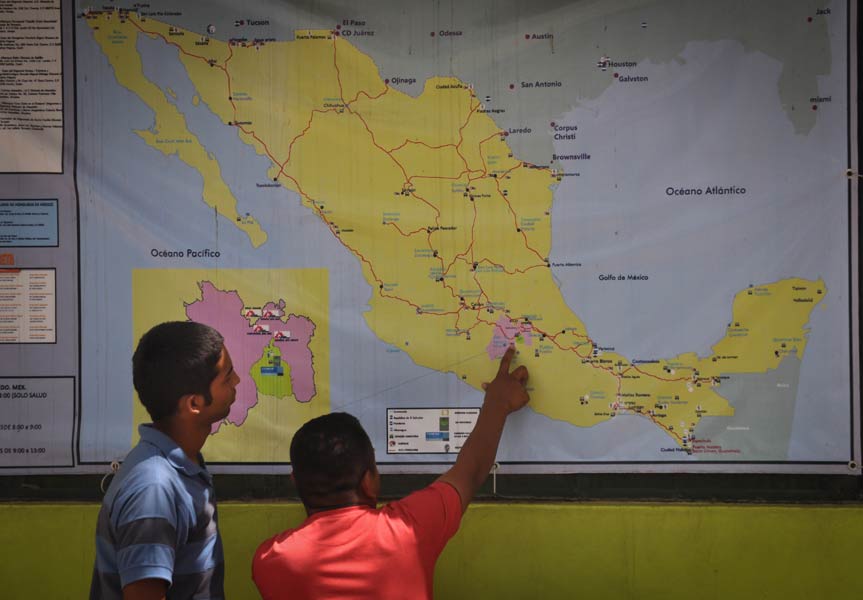
Two migrants in a shelter in Ixtepec, Oaxaca, look over the routes they can take to the U.S. border, more than 800 miles away.
The plan also calls for railroad companies to take steps to deter migrants. Some have increased the speed of trains so that migrants can’t climb on board. In Apizaco, Tlaxcala, a small city about 80 miles from Mexico City, companies have installed short concrete poles next to the tracks to deter migrants from running alongside and hopping the trains.
La Sagrada Familia, a shelter in Apizaco, is located only about 30 feet from the embankment along which La Bestia runs. In October, a few hours after leaving the shelter, a migrant named Arlem Nahúm Zepeda Martínez attempted to climb onto a slow-moving train. He hit one of the concrete poles and was swept under the train and killed. Carla Patricia Juarez Peña, coordinator of human and community development at the shelter, says 14 migrants in Apizaco have been injured by the new poles.
Some railroad companies, especially in the north, have also hired custodios, private security, to keep migrants off the trains. They dress completely in black, with masks (called pasamontañas) covering their faces, maximizing intimidation. They often carry rifles and pistols. Migrants report custodios robbing them of whatever they have: money, shoes, even their clothes.
“In Orizaba, custodios stole my money,” says Juan Carlos Reyes Guillen, a 22-year-old Honduran staying at the shelter in Apizaco for a couple of days in late January. “The train was stopped and the custodios said, ‘Everyone down.’ ” Pointing rifles at the migrants, they took 2,000 pesos (about $130) from Guillen. He had a few more pesos tucked in a shoe and was able to take a bus to the shelter.
Guillen is hoping to make it back to Dallas, where he lived for 12 years. A few hours after we spoke, he packed his small backpack. It contained shower shoes, hair gel, toilet paper and a small mirror, which he held up, smiling shyly. He zipped up the backpack, shook my hand and headed north.
Worse than ‘The Beast’
Even before the Programa, the 400,000 Central American migrants who attempt to cross Mexico each year faced grave risks. In addition to the perils of La Bestia, there are the predations of gangs. Reliable statistics are hard to come by, but Amnesty International and other sources say that gangs routinely assault, rob, kidnap and murder Central American migrants. A 2010 report found that 60 percent of women migrating through Mexico were raped. WOLA estimates that 20,000 migrants are kidnapped each year. A survey of morgues and cemeteries by Mexican newspaper Milenio found that an average of 4,000 unidentified bodies are buried annually.
But Programa Frontera Sur has made things even worse, according to the 60 advocates, shelter workers and migrants I interviewed during a seven-week trip this winter along one of Mexico’s main migration routes. Almost all of the 35 migrants I met spoke of walking for days between shelters, on routes that exposed them to increased danger. “More people are assaulted, more women are raped, more people are disappearing,” says Ojalvo, the shelter worker.
“We thought we could not see anything worse than the train,” says Luís López-Lago Ortiz, who works with Scouts de Extremadura, a Spanish NGO. “But there is something worse: walking on the road.”
An emergency shelter
In response to the flood of migrants traveling on foot, in September Padre Alejandro Solalinde, the founder of the shelter in Ixtepec, opened an emergency shelter in Chahuites, Oaxaca, a small city about 100 miles east of Ixtepec. According to Carlos Moriano, the shelter’s coordinator, “Almost everyone reaching the shelter has been assaulted.”
Chahuites is a poor town, filled with small houses constructed of unpainted cinder blocks, many with tin roofs. The entire front of the store adjacent to the shelter has bars across it; money and merchandise are exchanged through the gaps. When I arrived in February, Moriano took me aside and told me never to leave the shelter alone because of the risk of being robbed.
The shelter holds between 40 and 50 migrants in conditions that resemble a refugee camp. It was previously an abandoned house, and with migrants arriving daily, there’s been little time to fix it up. There’s no privacy, no personal space. Migrants sleep on thin mats in a small courtyard. In the morning, the mats are rolled up and stored on shelves. There’s just one shower stall, one small utility sink for washing up and brushing teeth, and a bathroom that’s a cement toilet over an open hole.
Migrants’ shoes are badly worn, and almost every migrant I observed walked with a limp. Like many, Isamel, a Honduran woman I met at the shelter, had a badly infected wound on her foot. She was traveling with her husband and cousin, walking most of the time because “combis [vans] cost too much.” On their way to the shelter in Arriaga, Chiapas, three men with guns took all their money: about 700 pesos ($50). But Isamel counts herself lucky: “The important thing is they did not beat us, or rape.” When asked how she could continue after the assault and with an infected foot, she said, “I do not care. We are leaving. That is the spirit you have to have.”
Until last summer, there were few reports of migrants being assaulted within Chahuites’ borders. Now that migrants are walking through the town rather than riding La Bestia, that has changed. One afternoon, Moriano asked if I wanted to see the area where criminals attack migrants. I held up my camera. “Is it safe to bring this?” I asked. “Yes,” he replied. “We are bringing machetes.”
Eight of us left the shelter and walked along a well-worn dirt path that parallels the train tracks. It’s the same path migrants walk. Fifteen minutes later, Moriano pointed to an overgrown area on the other side of the tracks, and we crossed. In a small clearing lay a woman’s boot and some clothes. This is where women are taken to be raped.
On a barbed wire fence behind the clearing hung three pairs of women’s underwear, neatly pinned: sick trophies. A few feet away lay more clothing and bras, and a dirty sleeping bag. A few weeks after my trip, Moriano and some volunteers cleared the weeds from that area so it would be more easily seen from the path and burned some candles to purify it.
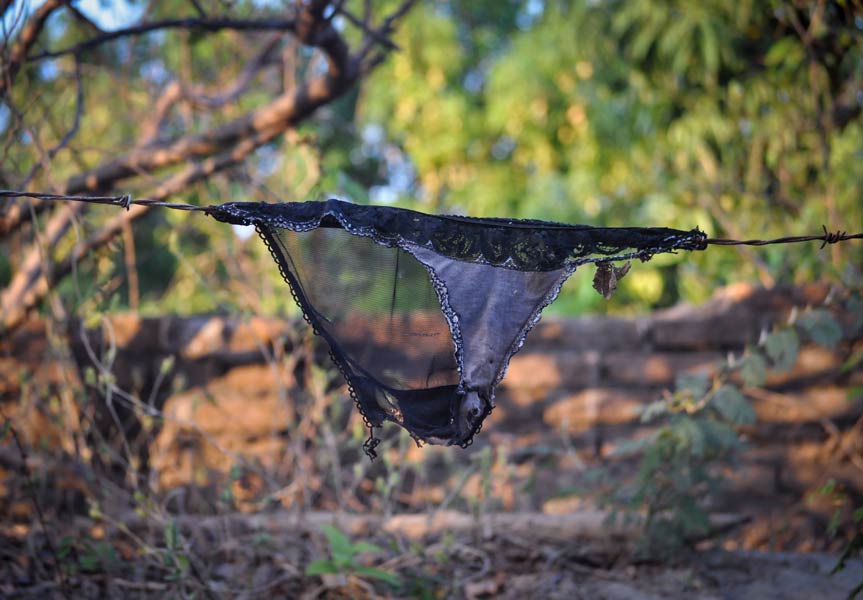
A woman’s underwear hangs on the barbed wire that rings an area in Chahuites, Oaxaca, where migrant women are raped.
According to Moriano, some of the rapes in Chahuites are carried out by residents. “We hear this from someone who tells someone, who tells us,” he says.
For the most part, however, it’s gangs that prey on migrants crossing Mexico. Although the increased policing of trains under the Programa is ostensibly to protect migrants, there’s no evidence it has curbed the predations. The few migrants who still manage to ride the trains remain subject to extortion. Gangs demand a cuota, or fee, of $100 from migrants who attempt to board trains in several cities, including Palenque and Orizaba.
“We do not have that kind of money,” says José Daniél Sanchez, an 18-year-old Honduran who could not afford the cuota in Palenque. “We are poor. We are not the owners.” Migrants who can’t pay may get lucky, as Sanchez did, and simply be passed over. But it’s more likely they’ll be beaten and denied access to the trains, or thrown off, kidnapped or killed.
Deport at all costs
Provisions in Programa Frontera Sur call for Mexican agencies to respect migrants’ human rights. That sounds good, but in practice, says Alberto Donis Rodríguez, coordinator of the shelter in Ixtepec, “It is totally the opposite. It is a vile hunt.”
According to everyone I interviewed, Programa Frontera Sur has brought a dramatic increase in what Mexicans call operativos: raids by police and INM on trains and buses, in which suspected migrants are rounded up and deported. Migrants also report INM making arrests outside shelters, which is illegal, and breaking into hotel rooms where migrants are staying.
There are increasing reports of brutal force by INM officials. Several migrants said agents were using Tasers, and shelter directors and advocates say they’ve heard this repeatedly. One migrant reported being shot at by INM agents. Another described an incident in which INM agents set fire to a pasture to flush out migrants. Several were reportedly hospitalized with burns.
There are also disturbing reports about Grupo Beta, a unit of INM whose job is to give aid and protection to migrants. They’re easily recognizable, dressed in bright orange shirts and khaki pants. “Before Programa Frontera Sur started, they were really a help,” says one advocate, who asked not to be named. “Lately, everything has changed. We’ve had reports of migrants saying that they heard Grupo Beta members calling immigration police to tell them where they were going to leave migrants so they could arrest them.”
If the real intent of the Programa is to keep Central Americans, particularly children, from reaching the U.S. border, it is working. In the six months after the plan was enacted, deportations of Salvadorans, Hondurans and Guatemalans from Mexico rose by 34 percent, while apprehensions of those Central Americans by U.S. Border Patrol dropped by 39 percent, according to statistics provided by Border Patrol. And the number of unaccompanied Central American children apprehended at the U.S.-Mexico border fell by 57 percent, from 45,000 in the first six months of 2014 to 19,000 in the last six months.
U.S. Immigration and Customs Enforcement does not expect another surge in Central American children migrating this summer. “I’m happy to say all the work we’ve done last year is bearing fruit,” ICE Deputy Director Daniel Ragsdale said at the Border Security Expo in Phoenix in April. When asked what that work was, an ICE spokesperson directed In These Times to a press release about beefed-up U.S. border staffing and technology.
Yet none of this will stop migration. “If there is a wall, they will go around it,” says Rubén Figueroa, coordinator of the human rights group Sureste del Movimiento Migrante Mesoamericano. In addition to walking along new routes, some are taking boats along both the Pacific Coast and the Gulf. Their reasoning is simple, says Ojalvo: “ ‘If I stay, I die. If I go, I may die.’ They choose between certain and possible death.”
Why they fled
Of the estimated 400,000 Central American migrants who enter Mexico each year, the overwhelming majority plan to make it to the United States. Most come from the Northern Triangle countries — Guatemala, Honduras and El Salvador — which are among the most impoverished and violent in the world. According to the World Bank, as of 2011, 53.7 percent of Guatemalans live in poverty, defined as not having the resources or abilities to meet one’s daily needs (the equivalent of $1.25 per day in U.S. dollars). As of 2013, 29.6 percent of Salvadorans live in poverty, and Hondurans fare even worse, with 64.5 percent in poverty. In addition, these countries are plagued by unimaginable levels of violence. A 2014 UN report revealed that Honduras has the world’s highest murder rate, El Salvador ranks fourth and Guatemala fifth. Much of this violence stems from the gangs Mara 18 and Mara Salvatrucha (MS-13).
Both gangs started in Los Angeles in the 1980s. In 1996, the United States began deporting gang members. “When they returned home,” says WOLA’s Meyer, “they set up their gangs in Central America and began recruiting more members.”
That’s just one thread in the United States’ tangled involvement with the Northern Triangle, which goes back more than a century. Notable “interventions” include a CIA-backed coup in Guatemala in 1954, strong support for the Salvadoran military during the 1980 to 1992 civil war, and training a Honduran army unit implicated in killing civilians in the 1980s. These actions increased the instability — and violence — in the region.
Most migrants I met were fleeing gangs. César Augusto Cruz, a 43-year-old Guatemalan, says that as a bus driver, he had to pay 100 quetzales ($13) a week to the Mara 18.
“To live in my community, you have to pay the gangs,” says Jorge (who didn’t want his last name used), a Salvadoran migrant who earned $50 a week painting buildings. “If not, they will kill you. I have to pay $5 a week just to live on my own property.” Jorge walked 20 days to travel the 500 miles from Ixtepec to La Patrona, Veracruz, putting in about 25 miles a day. “It is like a marathon,” he says, “but there is no prize at the end.”
Extortion isn’t the only way gangs prey on people: They also forcibly recruit young men. I met Herbert, a quiet 17-year-old Guatemalan, when he was staying with his family at the shelter in Ixtepec. His mother, who was with him during the interview, didn’t want their last name used.
Herbert was playing soccer one January afternoon in a park near his home when members of a gang — he didn’t specify which — approached him. “They told me I had to go to a house of this gang member and if I didn’t, they would kill my mother or brother,” he says. “We arrived and the boss said, ‘If you do not join, we will kill all your family.’ He said to go and return tomorrow.” Herbert went home and told his parents what had happened. They packed up what they could and left that same day, walking and taking buses through Mexico, aiming for the United States. On one stretch, the family, including 8-year-old José, walked 10 hours a day for four straight days.
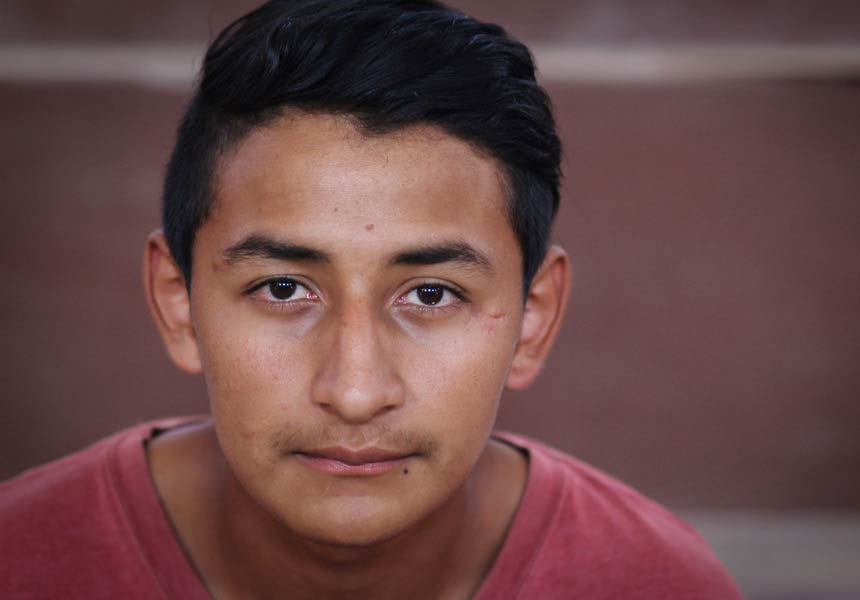
Herbert, 17, in Ixtepec.
Outside of La Reforma, a small town in Oaxaca, the family was robbed at gunpoint. “They took all our money,” says Herbert’s mother, Monica. That was 400 pesos (about $26), and they had to beg in the street for bus fare to the shelter. In spite of all this, Monica remains optimistic they’ll reach the U.S. border and will be let in. She says a friend of hers had gotten there and turned herself over to U.S. authorities. Because her friend had her two sons with her, they let her stay. Monica plans to do the same thing. If they don’t let her in, she wants to stay in Mexico. “I cannot return to Guatemala,” she says.
In addition to gangs, many migrants are fleeing narcos, or drug traders. Tomás Francisco Álavarez Nuñez, a former Honduran soldier I met at the shelter in Apizaco, was in a battalion that pursued narcos. During one operation, someone recognized him and tipped off the narcos.
“The narcos were looking for me,” he says. “They knew where I lived, what I did.” Knowing they would kill him if they found him, he resigned from the army, and in early January, he left Honduras. He knows that to return is a death sentence. When he was told it is increasingly difficult to cross into the United States, he said, “I prefer to be in prison than to return.”
Natalie Reyes is one of the few migrants I met whose decision to leave was primarily a financial one. A buoyant 22-year-old with large, dark eyes and a nearly constant smile, she is also eight months pregnant. She left Honduras four months earlier, funding her trip by selling small cloth bracelets and hairpieces along the way. She left her 6-year-old son with her sister because she knew she couldn’t earn enough to support two children. “If I stayed in Honduras,” she says, “we would starve.”
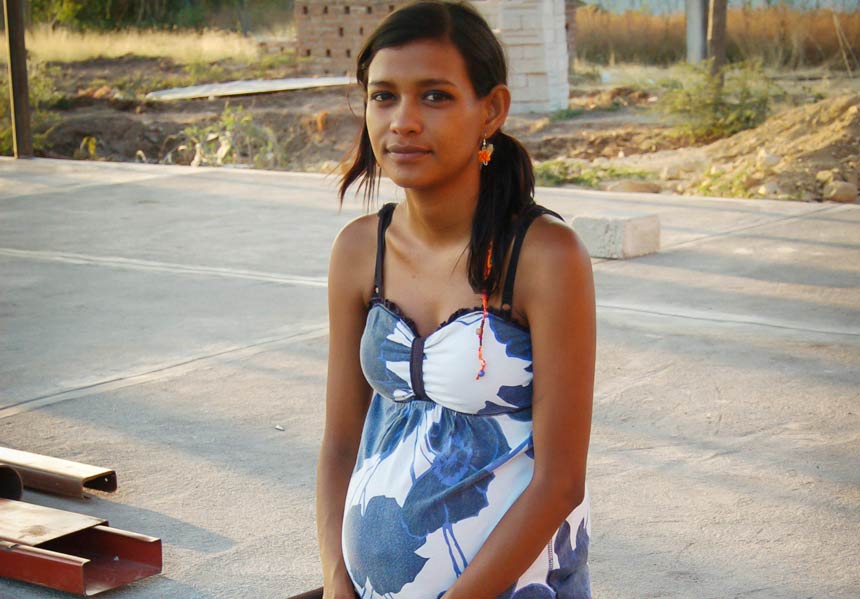
Natalie Reyes, 22, outside the shelter in Ixtepec.
What the United States can do
Advocates say that the United States could change the way Programa Frontera Sur operates. “The U.S. government has a strong influence with Mexico, and it does have an obligation, since it is providing funds in millions of dollars every year to Mexico,” says Diego Zavala, Amnesty International USA’s specialist on Mexico.
But Programa is in keeping with immigration policies in the United States, Mexico and Central American countries, which have tended to look for punitive ways to keep undocumented people from crossing the U.S. border. WOLA’s Meyer thinks this is the wrong approach. “There is a need to address the root causes of migration … in terms of economic development,” she says, “but also to address the widespread violence that is causing thousands of migrants to flee their homes.”
In February, President Obama proposed a $1 billion aid package to El Salvador, Guatemala and Honduras that aims to do just that. Meyer says the request is a step in the right direction, noting that 80 percent is earmarked for economic and civilian programs, rather than military or policing. She is optimistic that it will be approved by Congress, though the amount may change. But a position paper from WOLA cautions that the money must be “invested wisely,” rather than funneled to corrupt agencies and politicians, and that this will require far greater transparency than in the past.
Until conditions improve, Meyer says, “the situation in Central America should be addressed not as a migration crisis, but as a refugee crisis.” According to a June 2014 report by WOLA, many of the migrants fleeing violence should be eligible for asylum.
The inequities and extreme violence that are driving people out of Central America continue unabated. Advocates believe the same number of migrants will still enter Mexico, trying to make it to the United States. And migrants are as determined as ever to make it there. “If they are going to kill me, let them kill me on the road,” says Jorge, the Salvadoran migrant. “I am only trying for a better future for my family.”
This article was supported by grants from the Leonard C. Goodman Institute for Investigative Reporting and the Puffin Foundation.
All photographs by Joseph Sorrentino. See more at www.sorrentinophotography.com.
